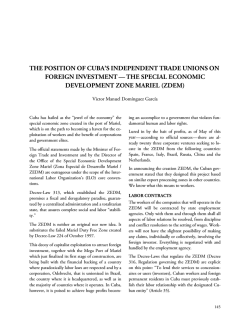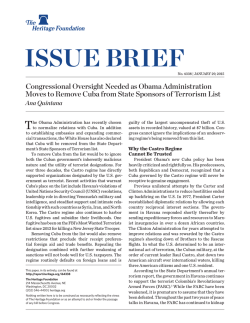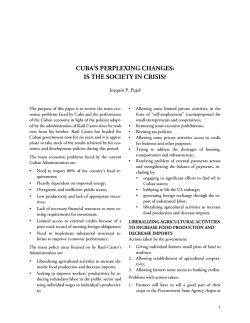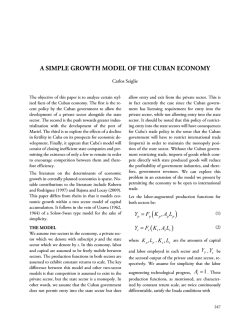
Jorge Perez-Lopez - Association for the Study of the Cuban Economy
NEW OPPORTUNITIES FOR BUSINESS AND INVESTMENT BY AMERICANS IN CUBA UNDER THE ECONOMIC OPENING Antonio R. Zamora I have regularly visited Cuba several times a year since 1998. My many visits have been to do professional research and to attend and participate in legal conferences mostly having to do with foreign investment. All my visits and activities in Cuba are legally based on U.S. law. As many other observers, I have witnessed a very restrictive and tentative effort by the Cuban authorities to promote foreign investment. My main area of interest has been real estate sales and development. Condominiums were sold in Havana in the mid1990s, but after a few short years, construction and sales of condominiums were stopped and the effort ended. A few years later a new development effort to promote the construction and sales of large residential projects, some with golf courses and marinas, was initiated. However, after more than ten years of studies, negotiations, new legislation, etc., only one project has started construction, namely the Carbonera project near Varadero. In my opinion, the reasons for the delay of these large real estate projects has to do with the legal rules to be applied, problems with marketing and the substantial cost of building and developing large projects. It has been very frustrating, but I am certain that in due time most of these projects will go forward. Other areas approved for foreign investment will go forward at a much faster pace. I do believe that the economic opening is real, is moving forward and it will change Cuba’s economy and society. This transformational process is based on some important factors. First, there is a generational change due to biological imperatives. Second, there is a real concern about the future of the Venezuela-Cuba relationship. Third, Cuba’s economic model has failed. It needs more private business and substantial foreign investment. This is now an important topic of discussion in the Island. Fourth, the U.S.-Cuba relationship is changing in favor of more engagement and less antagonism. Recent events, such as the visit to Cuba by the President of the U.S. Chamber of Commerce and the on-going negotiations between Cuban and U.S. representatives, are evidence of a changing relationship. Fifth, the Cuban-American community of the United States is also changing its position in relation to Cuba, the embargo and U.S. politics. Now even in the State of Florida there is a majority in favor of better relations with the Island. AREAS OF INTEREST FOR INVESTMENT AND BUSINESS BY AMERICANS By Americans, I mean all individuals and businesses based in the United States. This, of course, includes Cuban-Americans, Latin Americans, Europeans, etc., living in the United States with U.S. citizenship or as residents. It also includes individuals with more than one citizenship. This is based on my own research and analysis, especially in the last year or two. I will not disclose my sources of information because it is a sensitive topic. Also, clients and business associates are involved. There are a number of areas for investment and business in Cuba that are of special interest to Americans. 139 Cuba in Transition • ASCE 2014 I will concentrate on only three: (1) the Mariel Free Trade Zone; (2) nautical activities including marina developments and complementary business activities, such as boatyards; and (3) real Estate sales and developments including large developments, retirement in Cuba and individual purchases. consulting services, logistics, transportation, etc. Users can rent an office, a warehouse, etc. Consignees can do residential real estate development, offices, hotels, warehouses, etc. Users and consignees will have 10 years of no taxes on profits and a tax rate of 12% on profits after the 10 years. The Mariel Free Trade Zone (MFTZ) The Mariel Special Development Zone (MSDZ or MFTZ) was created by Decree Law 313 dated September 23, 2013. The MFTZ covers Mariel Bay and some 180 sq. miles East, West and South of the Bay. Mariel Bay is about 30 miles West of Havana. The Law creates a special customs area or free trade zone where goods may be landed, handled, manufactured or reconfigured, stored, deposited, completed, commercialized and re-exported without the intervention of Cuban customs authorities. The MFTZ could have an important impact on the United States embargo on Cuba. Present U.S. law prohibits a vessel which enters a Cuban port to engage in trade of goods or services to enter a U.S. port for 180 days after departure from Cuba. However, the Secretary of the Treasury may issue a license allowing vessels trading with Cuba to enter or return to U.S. ports without delay. Since 2002, U.S. vessels are allowed to take U.S. food exports to Cuba and return to the U.S. empty. This increases the cost of U.S. agricultural goods sold to Cuba and makes them less competitive. The objectives of the MFTZ are to promote national development, exports and import substitution, promote technology and know-how, attract foreign investment, create new forms of financing, promote employment, protect the environment, develop logistics systems and infrastructure to create efficient import, export and distribution systems and promote the creation and establishment of national and foreign enterprises. The MFTZ has three other very important objectives: (i) replace Havana harbor as the commercial port of Western Cuba, with the port of Havana dedicated to tourism; (ii) accept and handle the cargo of large container vessels that will transit from the Pacific to the Atlantic via the expanded Panama Canal; and, (iii) become the leading container terminal and free trade zone of the Caribbean, located less than 120 miles from the United States. The MFTZ is being built by the Brazilian construction company Odebrecht. Most of the funding for the development of the MFTZ is being provided by Brazil. In charge of management of the port is Singapore’s PSA International. A number of companies from Brazil, China, Russia, Canada and Latin America have indicated their interest in establishing operations in the MFTZ. Users and consignees can engage in all kind of activities including manufacturing, construction, marketing, banking and financial services, management, 140 Already, U.S. ships taking food exports to Cuba are going to Mariel instead of Havana. There are already lobbying efforts by U.S. exporters of agricultural products to Cuba in favor of having the ships that deliver their products be allowed to return with nonCuban products from the MFTZ. This will benefit American Agricultural interest and it only requires the approval of the Secretary of the Treasury. Nautical Activities Including Marina Developments and Complementary Business Activities The Island of Cuba has always had a special attraction for mariners, starting with Christopher Columbus, who called it “the most beautiful land that human eyes have seen.” Indeed, Cuba is a beautiful subtropical island, by far the largest in the Caribbean, with almost 2,000 miles of coastline and a fascinating history. Cuba has a land area of more than 110,000 square kilometers and a population of more than 11 million. The island has numerous bays and protected coves and more than 4,000 cays and islets. It also has some of the best fishing and diving in the world. Cuba has a well-developed tourism industry that receives close to three million tourists annually. However, compared to the rest of the Caribbean, its nautical tourism is almost non-existent. The Bahamas New Opportunities for Business and Investment by Americans in Cuba has more than 70 marinas and more than 3,500 slips, while Cuba has only 15 marinas with approximately 800 slips. Cuba is much larger than the Bahamas, which has a land area of only 14,000 square kilometers and about 350,000 inhabitants. The University of Florida did a study a few years ago on how the recreational boating industry of both Florida and Cuba would benefit from unrestricted boat traffic between the two. The study estimated that more than 50,000 yachts from Florida would visit Cuba each year if there were no restrictions. Reliable sources estimate that in recent years about 3,000 U.S. based boats visit the island every year. The number of boats that travel to the Bahamas from Florida every year is estimated at around 40,000. Cuba is a lot more attractive as a boating destination than the Bahamas. Therefore, the estimate of 50,000 is quite reasonable. The State of Florida has more than 100,000 boats registered in the State that could go to Cuba. This number does not include thousands of boats that have Federal or foreign registration but are based in Florida. In addition to pleasure boating, Cuba could be a destination for yacht repairs and maintenance. The stars of the yacht cruising world are the mega yachts that have a length of more than 100 feet. The Marine Industry Association of South Florida (MIASF) estimates that there are at least 2,000 mega yachts that spend a substantial amount of time in the Tri-County region of Dade, Broward and Palm Beach. According to the MIASF, mega yachts spend about $200,000 per year in local boatyards. In addition, they spend about $300,000 per year in supplies, fuel, charter fees, brokerage commissions, etc. The repair, maintenance and service of the mega yachts industry in the Tri-County area is not growing, in fact it is losing ground. The relative decline of the boatyard industry in the Tri-County area is the result of a number of factors, including but not limited to the following: • Reduced number of land sites for boatyards. Many potential land sites and even existing boatyards have been converted to residential or commercial development. • • • • Reduced accessibility by large recreational yachts to boatyards. Some boatyards were built decades ago, when yachts were smaller, and are no longer accessible to the new larger yachts. The steady increase in the size of mega yachts has also created haul-out problems in some boatyards. Labor costs and training issues. Skilled labor is in limited supply in the Tri-County area and the cost of the available labor is increasingly higher than what is available in other areas. Environmental restrictions. Environmental compliance costs and restrictions are increasing in the Tri-County area to the point that it is negatively impacting local boatyards. The Florida Sales Tax on vessel repairs and service is clearly another negative aspect. The Florida Sales Tax also affects the purchases of equipment that may also be a concern in the case of sales of mega-yachts and even on the extended stays in the area. As a result of these and other problems, such as availability delays of up to six months, some large yacht repair and service related business have left the TriCounty area to settle in other places. Cities such as Savannah (Georgia) and Freeport (Bahamas) have received some of this business. This situation creates an opportunity for boatyards in Cuba to provide services to large recreational yachts including mega yachts. The ideal locations for boatyards in Cuba are in the Western part of Cuba’s northern coast, from Varadero to the MFTZ. Apparently Cuba’s leadership is aware of the business and investment potential of nautical activities. Cuba’s Council of Ministers adopted a law (Decree 314) on November 21, 2013 dealing with and endorsing nautical tourism. The new law established the length of stay of foreign yachts, procedures to clear customs, repair and maintenance services and created a National Commission on Nautical Matters to be presided by the Minister of Tourism. One of the most important parameters established by Decree 314 is the length of stay in Cuba of pleasure yachts. After the adoption of Decree 3l4, the length of stay in Cuba of pleasure boats is five years with the possibility of renewal. There is no fee or charge for 141 Cuba in Transition • ASCE 2014 this five-year stay and there is even the possibility of extending the stay beyond five years. In Florida the length of stay without payment is 90 days for nonBritish registered yachts. British yachts can stay one year without payment. The businesses of cruise ships and ferries have been on the radar for years. The cruise ship industry of South Florida has been interested in Cuba for a long time. The Caribbean is the number one destination in the World for cruise ships and Cuba will add to the number one ranking. There is at least one application pending with OFAC for ferries from South Florida to Cuba. This will be for individuals that have a license to travel to Cuba and for cargo that normally travels by plane. Of course, Cuba has to approve the arrival of the ferries and provide the facilities to handle the ferries in a Cuban port. • • • • Real Estate Sales and Developments Including Large Development, Retirement in Cuba and Individual Purchases In November, 2011 a new law went into effect allowing Cubans to buy and sell their homes without authorization from the government. The sale price is determined by the parties to the sale. This is a radical change from the permuta model that existed in Cuba for many years. The permuta is somewhat similar to the concept of “light kind exchange” in U.S. law. The new law even allows Cubans to sell their homes before leaving the country and keep the proceeds of the sale. The government has also established new procedures to register and transfer titles. The new law has created a residential real estate market similar to what is in existence in developing countries. The one big limitation is that under current Cuban law you can only own a principal residence and a beach or country second home. Another important limitation is that the owner cannot mortgage the principal residence. Cuba has several characteristics that favor the new real estate law and suggest that it will have a substantial impact on Cuban society and economy: • 142 Cuba has more than 3 million homes. Approximately 90% of these homes are owned by the oc- • cupants. This is one of the highest home ownership ratios in the world. Cubans, under current law, are allowed to have a country home or a beach house. Therefore, there is the possibility of more than 3 million second homes being incorporated into the new housing market. Cuba has a large and relatively wealthy Diaspora close by in the United States. The U.S.-based Diaspora is now sending more than three billion dollars per year to Cuba in cash and goods. The U.S. Diaspora is also visiting Cuba at the rate of more than 400,000 individual visits per year. For the Cuban Diaspora, retirement in Cuba is relatively easy. You have to be at least 62 years of age, have a place to reside in Cuba and sufficient income in hard currency to support yourself. You also need a Cuban passport/citizenship. There is the possibility of expanding the primary residence. For example, adding rooms, building a second story, selling air rights, developing a business like a paladar or a bed and breakfast, renting part of the house, etc. Finally, Cuba has a very low population density compared to other Latin American and Caribbean countries. Therefore, there is a lot of room for different forms of real estate development. The Foreign Investment Code, Law 77 of September, 1995, opened Cuba to foreign investment in real estate. Hotels and condominiums were popular with foreign developers, investors and buyers in the 1990s. Condominiums were built and sold mostly in Havana and many hotels were built all over the Island. Condominiums were sold as fee simple, based on the Condominium Law of 1952. For a variety of reasons the sale of condominiums was basically terminated in 2000. The hotels were built based on a 25 to 50 year lease between the Cuban government and the joint venture company doing the development. Golf and marina residential development started to be discussed almost ten years ago as a way of improving tourism. The successful example of the Dominican Republic was cited by the promoters of this form of development. Because of the large investment required for New Opportunities for Business and Investment by Americans in Cuba this type of development, a better land deal was needed. After considerable analysis and discussion, a new law was approved extending the lease term to 99 years in August 2010. The new law also created the possibility of a lease in perpetuity with the Cuban joint venture company. Finally, on March 29, 2014, Cuba’s National Assembly passed a new foreign investment law that is an improvement of Law 77 of 1995. Time will tell how much foreign investment the new law will attract. Some of the benefits of the new foreign investment law include a faster approval process for real estate and golf ventures, special economic zones, marina developments and new manufacturing projects, a ten year reprieve from paying taxes, lower taxes on profits, etc. In the United States there is substantial interest in Cuba as a real estate development opportunity. Cuban-Americans under present rules can live and retire in Cuba as long as they have relatives in the Island and or Cuban citizenship. It also helps if they have U.S. citizenship. They can send to their relatives in Cuba as much money as they want and stay in the Island as long as they want. Americans can invest indirectly in real estate development in Cuba under the 49/49 rule. This means that the investment must be non-controlling, in a third country company, not U.S. or Cuba, and the company has to generate most of its income from outside of Cuba. In the case of the golf and marina residential projects, income from Cuba will not be generated for several years. The legal basis for these types of investment originates from a letter from the Department of the Treasury in response to an inquiry by a U.S. business group. The letter, dated March 4, 1994, was signed by Richard Newcomb, at the time Director of the Office of Foreign Assets Control (OFAC), which is the office in the Department of the Treasury responsible for enforcing the Cuban embargo. In the letter Newcomb wrote: “A U.S. company or individual may make a secondary market investment in a third country company doing business in Cuba provided that the investment does not result in control in fact of the company by the U.S. investor. A secondary market investment that falls short of a controlling interest is not prohibited.” There are many examples of 49/49 investments by U.S. companies in third country public companies. JP Morgan-Chase owned shares of the Spanish company Repsol, the company that was drilling for oil in Cuba, American Airlines had an interest in Iberia Airlines, which had an office and regular flights to the island, the French hotel company Accord had the U.S. investment fund, Colony Capital, as one of its investors, the Fiat Group, with operations in Cuba, had General Motors as one of its investors, etc. Two other important 49/49 investments are Copa/ Continental Airlines and Anheuser-Busch/Imbev. Both companies are traded in the New York Stock Exchange. Copa Airlines in its internet advertising listed itself as an affiliate of Continental Airlines. At one point Continental Airlines owned more than 40% of Copa. Copa has five flights per day from Panama City to Havana and is one of the major carriers of passengers to Cuba. Copa also has a courier business in Cuba involving documents and merchandise. Copa has an office in the Miramar Trade Center in Cuba that highlighted its affiliation with Continental Airlines. It is clear that Continental Airlines was branding its name and company in Cuba. The situation of Anheuser-Busch Imbev S.A. is even more interesting because for a few days it became an issue during the U.S. 2008 presidential campaign. Imbev, which is a Brazilian/Dutch beer conglomerate, offered to buy Anheuser Busch in the summer of 2008. Mrs. John McCain, the wife of the presidential candidate of the Republican Party, was a shareholder of Anheuser-Busch. Part of the payment offered to Anheuser-Busch shareholders involved shares of Imbev. Imbev has a beer plant in Cuba which produces Bucanero, the second most popular beer in the country. They also have offices in Cuba and they represent many of the other Imbev products sold in the Island. The issue of the legality of U.S. citizens owning shares of a company doing business in Cuba was raised by opponents of the transaction. The Department of the Treasury very quickly confirmed the legality of the ownership of Imbev shares by U.S. citizens under the 49/49 rule. 143 Cuba in Transition • ASCE 2014 CONCLUSION It is evident that the Cuban government is promoting the MFTZ, nautical tourism and real estate development. It is interesting and significant that these three areas of development cannot be completely successful without American and Cuban American participation. The MFTZ is already the port of entry for U.S. ships delivering agricultural products to Cuba. U.S. yachts are visiting Cuba “illegally” some with the excuse of “emergency” repairs and most simply ignore U.S. 144 law. Others visit Cuba under license to participate on events such as The Hemingway International Billfishing Tournament. Finally, it is well known that Cuban-Americans, and even some Americans are buying houses and apartments in Cuba. At some point in the future, policy will catch up with reality in U.S.-Cuba relations. At that time it will be obvious that the economic future of Cuba, to be completely successful, depends on investments from the United States.
© Copyright 2025





